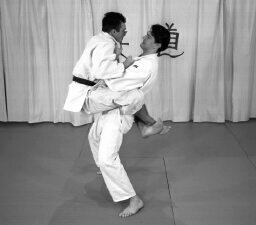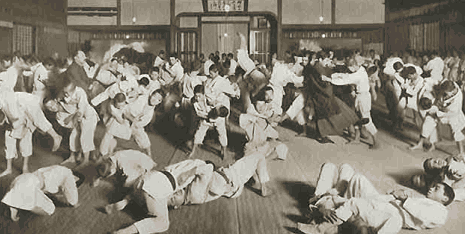High Lift  Neither the original Gokyo in 1895 nor the new Gokyo of 1920 had the Kodokan technique now called Daki-Age (high lift) listed. It appeared officially in 1982 as a new waza (a member of the group called koshiwaza or hip techniques). It seems, however, this waza existed from early days, though variously called Mochi-Age, Idaki-Age, Daki-Otoshi, etc. Daki-Age is performed when uke is on the ground with his legs around tori's waist. When tori is standing (or can raise up onto his feet), he lifts uke up by the lapels. Tori lifts up with the hands while thrusting his hips forward and under uke to get him as high as possible. The object of the lift is to slam uke back down onto his back. This can be very dangerous for uke who can find it difficult to protect his spine, neck and head. As a result, uke must prevent the lift or give up the grip with his legs. In 1925, the Butokukai ruled that once an opponent was lifted up to the shoulder level, an ippon should be called. At this point in time, it was allowed to slam uke on the tatami with no penalty. By awarding ippon however, there was no need for uke to be slammed. Both the Kodokan (in 1961) and the IJF (in 1967) applied the same rule, to call ippon when uke was lifted up to tori's shoulder level. Even then there was no penalty for slamming uke down on the tatami. The IJF (in 1981) and the Kodokan (in 1985) took Daki-Age out as a competition technique, matte was called as soon as uke was lifted off the mat, and a penalty was subsequently added for slamming uke onto the mat. Around 1925, Tsunetane Oda welcomed Daki-Age to become a competition waza from his unique viewpoint as one of the Kosen gurus. He said "it would eliminate clumsy Sankaku or Juji-Gatame for fear of being lifted up for ippon." He thought Daki-Age was possible because people were generally poor in grappling techniques. He wrote, "To prepare for Mae-Sankaku (triangle choke from the front), one has to first kick the leg of an opponent to lie him flat thus avoiding to be lifted up or flipped over." Apart from the safety issue in Daki-Age, there is a tacit rule in the Kodokan that no throwing technique is allowed from the mat position. For example, if Tomoe-Nage is done in a double motion where a tori, already lying on the mat, finishes by throwing uke, it's not considered as a valid throw. During the period from 1961 to 1981 in IJf sanctioned tournaments, there seems to be no official record of Daki-Age being scored for ippon. In 1982 Daki-Age was added to the Kodokan syllabus as part of the shinmeisho-no-waza. The technique is commonly used today in Mixed Martial Arts matches to defeat the popular guard position. 
I know not how to defeat others; I only know how to win over myself.
…..Yagyu Munenori
|